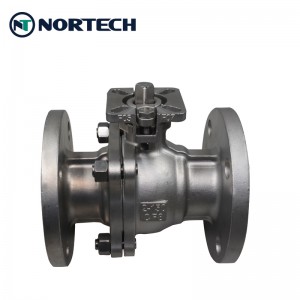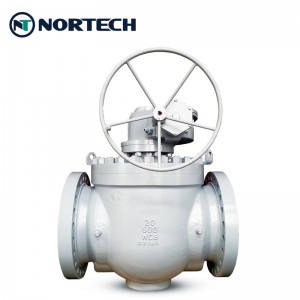As the most widely used valve, the ball valve is also the most type of valve. A variety of types meet the user’s application in different medium occasions, different temperature environments and different process requirements in the actual process. The following introduces the characteristics of several common ball valves such as floating ball valves, fixed ball valves, eccentric half ball valves, V-shaped ball valves and fluorine-lined ball valves.
According to structure and function, it can be divided into:
1. There are several types of ball valves. What are the floating ball valves: Floating ball valves are used as seals and the ball is floating. It uses the pressure of the medium to push the ball to move the distance and squeeze the elastic valve seat to achieve the sealing effect. This kind of float valve has a relatively large opening resistance and is only suitable for pipelines and equipment with a caliber of DN “200 and a pressure of PN “100. If the diameter of the ball is too large, it will bend the valve body and fail under the pressure of the medium; if the pressure is too high, the ball valve will be squeezed and elastically and the elastic valve seat will be permanently deformed, which may damage the seal and affect the ball valve. life.
2. The fixed ball valve is reset by the upper and lower stems. The valve seat is equipped with a leaf spring or a cylindrical spiral spring. When equipped, the spring of the valve seat is compressed to generate a pre-tightening force to achieve the initial seal of the valve, and the pressure is pushed during use. The valve seat moves to the ball to achieve a seal. Because the ball does not move, it is called a fixed ball valve. This kind of fixation is more reliable than floating ball valves because of its sealing reliability. It can be used in a wider range, not only for low-pressure small diameters, but also for high-pressure large diameters. But its structure is relatively more complicated
, The price cost is high, when choosing, you should choose according to actual needs.
3. Eccentric hemispherical valve. This kind of ball valve adopts an eccentric structure. The structure principle is the same as that of a multi-layer triple eccentric hard-sealed butterfly valve. The valve seat and the ball have no wear and have a tighter sealing function. The ball is only 1/4 of the ordinary ball valve. It has a curved surface, light weight and relatively low price. This has a shearing effect and can be used in a medium pipeline containing long fibers without jamming.
4. The flange of the thermal insulation ball valve is one to two specifications larger than the general flange ball valve. It adopts an integral valve body and a side-mounted ball design. A metal jacket is welded between the enlarged flanges on the outside of the valve body. Also called jacketed ball valve. Jacketed interfaces are installed on both sides of the valve body, which can be flushed with steam or other overheated gas to prevent the medium from condensing or crystallization at room temperature. Thermal insulation ball valves are mainly used in pipelines and devices that are easy to crystallize and require thermal insulation in petroleum, chemical, metallurgical, and pharmaceutical systems.
5. The V-shaped ball valve is a regulating ball valve. The flow passage hole of the ball is very different from the straight through hole of the ordinary ball valve. The ball has a V-shaped structure and usually adopts a fixed structure with two upper and lower stems.
6. Fluorine-lined ball valve is commonly used in low temperature and strong corrosive medium equipment pipelines. This kind of ball valve is lined with corrosion-resistant engineering plastics such as PFA or FEP in all parts of the flow channel that are in contact with the medium. It can replace expensive stainless steel and Hastelloy under the condition of not exceeding the service temperature of fluorine rubber in the low pressure pipeline. , Monel alloy, No. 20 alloy, solve the problem of transporting highly corrosive media in petrochemical and chemical pipelines
According to structure and function, it can be divided into:
1. There are several types of ball valves. What are the floating ball valves: Floating ball valves are used as seals and the ball is floating. It uses the pressure of the medium to push the ball to move the distance and squeeze the elastic valve seat to achieve the sealing effect. This kind of float valve has a relatively large opening resistance and is only suitable for pipelines and equipment with a caliber of DN “200 and a pressure of PN “100. If the diameter of the ball is too large, it will bend the valve body and fail under the pressure of the medium; if the pressure is too high, the ball valve will be squeezed and elastically and the elastic valve seat will be permanently deformed, which may damage the seal and affect the ball valve. life.
2. The fixed ball valve is reset by the upper and lower stems. The valve seat is equipped with a leaf spring or a cylindrical spiral spring. When equipped, the spring of the valve seat is compressed to generate a pre-tightening force to achieve the initial seal of the valve, and the pressure is pushed during use. The valve seat moves to the ball to achieve a seal. Because the ball does not move, it is called a fixed ball valve. This kind of fixation is more reliable than floating ball valves because of its sealing reliability. It can be used in a wider range, not only for low-pressure small diameters, but also for high-pressure large diameters. But its structure is relatively more complicated
, The price cost is high, when choosing, you should choose according to actual needs.
3. Eccentric hemispherical valve. This kind of ball valve adopts an eccentric structure. The structure principle is the same as that of a multi-layer triple eccentric hard-sealed butterfly valve. The valve seat and the ball have no wear and have a tighter sealing function. The ball is only 1/4 of the ordinary ball valve. It has a curved surface, light weight and relatively low price. This has a shearing effect and can be used in a medium pipeline containing long fibers without jamming.
4. The flange of the thermal insulation ball valve is one to two specifications larger than the general flange ball valve. It adopts an integral valve body and a side-mounted ball design. A metal jacket is welded between the enlarged flanges on the outside of the valve body. Also called jacketed ball valve. Jacketed interfaces are installed on both sides of the valve body, which can be flushed with steam or other overheated gas to prevent the medium from condensing or crystallization at room temperature. Thermal insulation ball valves are mainly used in pipelines and devices that are easy to crystallize and require thermal insulation in petroleum, chemical, metallurgical, and pharmaceutical systems.
5. The V-shaped ball valve is a regulating ball valve. The flow passage hole of the ball is very different from the straight through hole of the ordinary ball valve. The ball has a V-shaped structure and usually adopts a fixed structure with two upper and lower stems.
6. Fluorine-lined ball valve is commonly used in low temperature and strong corrosive medium equipment pipelines. This kind of ball valve is lined with corrosion-resistant engineering plastics such as PFA or FEP in all parts of the flow channel that are in contact with the medium. It can replace expensive stainless steel and Hastelloy under the condition of not exceeding the service temperature of fluorine rubber in the low pressure pipeline. , Monel alloy, No. 20 alloy, solve the problem of transporting highly corrosive media in petrochemical and chemical pipelines
Post time: Jul-08-2021


